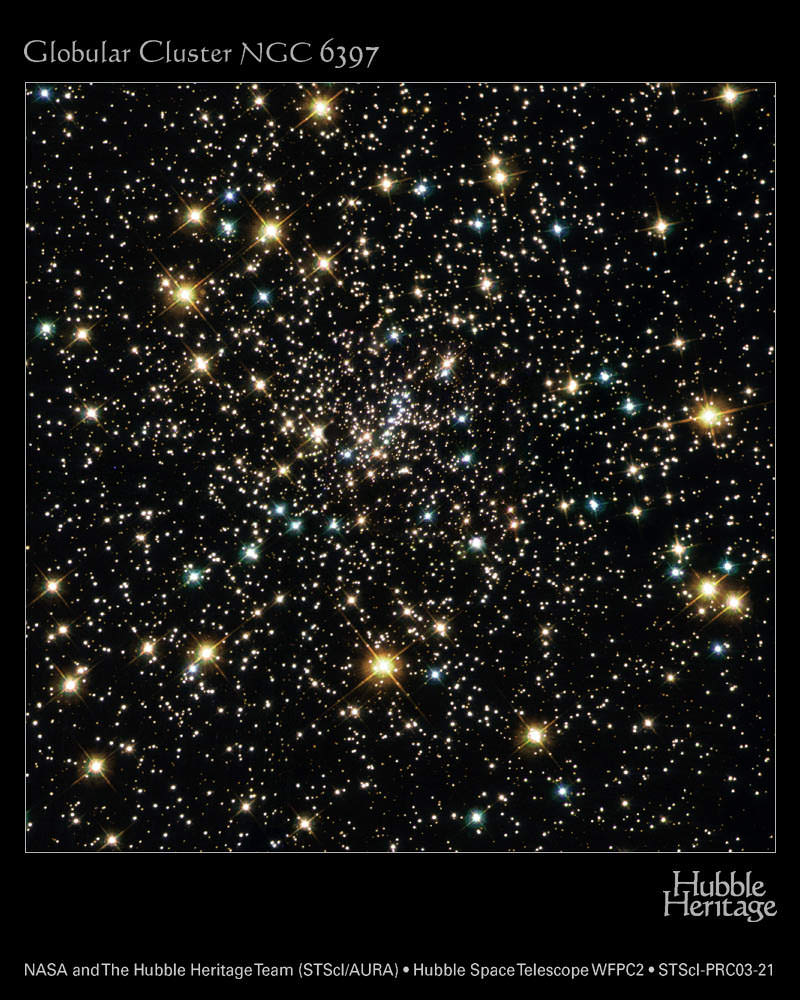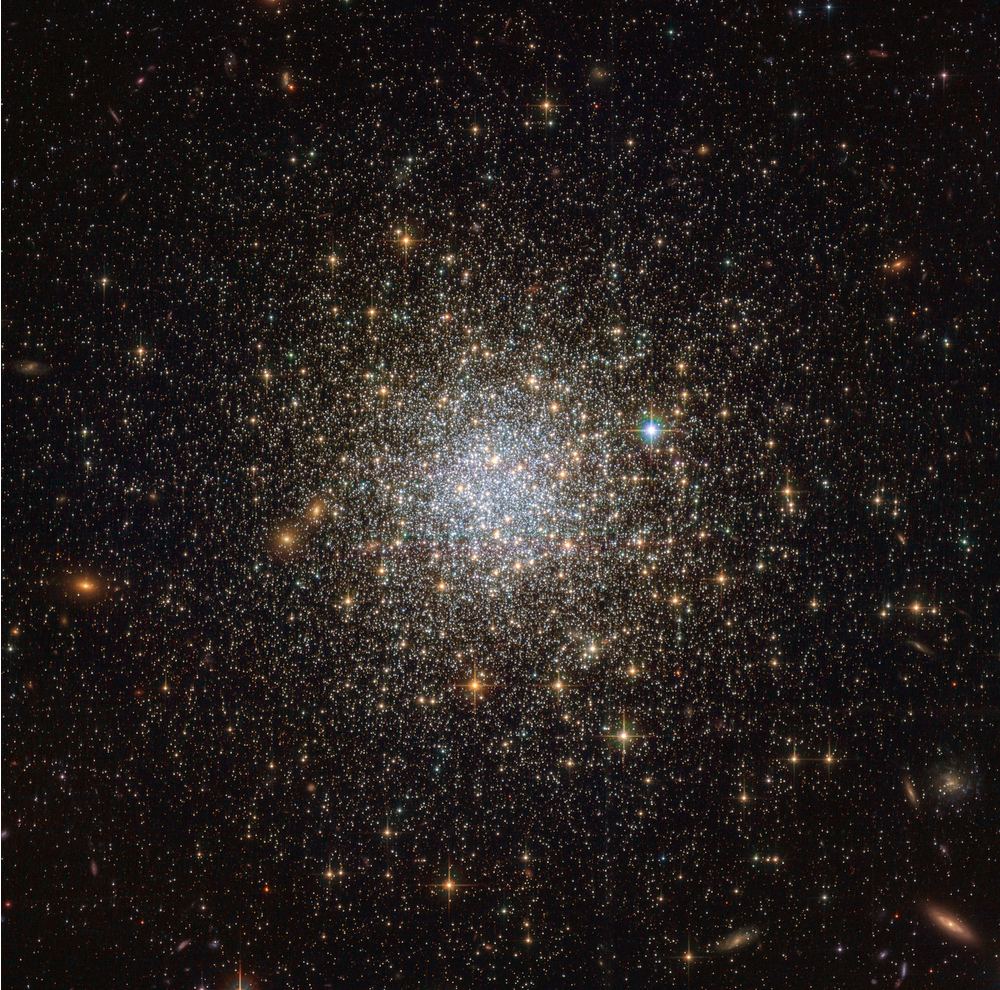The Venerable Hubble Space Telescope has cemented its place in history. Some call it the most successful science experiment ever. And while the James Webb Space Telescope might vie for that title, the Hubble does things that even the powerful JWST can't do.
Exhibit A: this stunning image of NGC 6355.
NGC 6355 is a globular cluster (GC) about 50,000 light-years from Earth in the constellation Ophiuchus. GCs are tightly-packed spherical groups of stars that can contain millions of stars. Astronomers aren't certain how many stars NGC 6355 contains.
Early astronomers couldn't discern GCs and thought they were individual stars. When telescopes came along, GCs looked like blobs, and some early astronomers thought they were comets. But the launch of the Hubble Space Telescope revolutionized the study of globular clusters. Above the Earth's atmosphere, the Hubble could get clear views of these objects.
Ground-based telescopes struggle to resolve individual stars in GCs. But the Earth's atmosphere didn't impede Hubble's observations. Ground-based telescopes have to deal with the light-distorting effects of the atmosphere, but the Hubble is above it all.
GCs are located in almost all galaxies. In spiral galaxies like ours, they're primarily found in the galactic halo. GCs are older than the other type of cluster, the open clusters (OCs.) GC stars have lower metallicity than stars in OCs and are some of the oldest objects in the Universe.
Globular Clusters are still mysterious objects. But the Hubble has studied them and removed at least some of the mystery. One burning question is whether or not GCs host black holes, much like galaxies do.
There are different sizes of black holes. The gravitational collapse of a star forms stellar-mass black holes. They range from about five to tens of solar masses. Supermassive Black Holes (SMBHs) are gargantuan and reside at the center of galaxies. They can contain billions of times more mass than the Sun. Then there are intermediate-mass black holes (IMBHs.)
But IMBHs are elusive.
When the Hubble came along, its ability to discern individual stars in GC helped astronomers detect IMBHs. The stars in a GCs center are more tightly packed than the stars toward the edges. That central region is where astronomers thought IMBHs might be hiding.
NGC 6397 is a globular cluster in the constellation Ara. It's about 7,800 light-years from Earth and is one of the two closes GCs. It holds about 400,000 stars. In a 2021 study, astronomers looked at Hubble images and data from other facilities to examine NGC 6397 for evidence of an intermediate-mass black hole.
Black holes can't be seen, so to infer their existence, astronomers study the motion of the stars in the GCs core. The black hole's massive gravitational force affects those stars' trajectories and velocities, and by measuring them, astronomers can estimate the black hole's mass. The 2021 paper found something extraordinary: there wasn't one black hole at the center of NGC 6397; there was a group of them.
"We found very strong evidence for an invisible mass in the dense core of the globular cluster, but we were surprised to find that this extra mass is not 'point-like' (that would be expected for a solitary massive black hole) but extended to a few percent of the size of the cluster," said Eduardo Vitral, one of the paper's authors.
Finding a clump of stellar-mass black holes was surprising and went against expectations. Astronomers thought that the cores of GCs were a likely place to find the elusive IMBHs.
The researchers haven't wholly concluded that the mass in the center of the GC is all black holes. They call it a CUO: a cluster of unresolved objects. The CUO has from 1000 to 2000 solar masses; whatever they are, they're dense.
The paper's authors say that stellar evolution explains what's likely there. They think the CUO includes the remnants of massive stars: neutron stars, white dwarfs, and black holes. Through a process called dynamical friction, more massive objects gradually sink to the GCs center while less massive stars migrate to the periphery.
"We used the theory of stellar evolution to conclude that most of the extra mass we found was in the form of black holes," said Mamon. Two other recent studies also proposed that stellar remnants, particularly stellar-mass black holes, could populate the inner regions of globular clusters. "Ours is the first study to provide both the mass and the extent of what appears to be a collection of mostly black holes in the center of a core-collapsed globular cluster," said Vitral.
None of this would've been discovered if it weren't for the Hubble. It had some help, especially from the ESA's Gaia spacecraft. But the Hubble's ability to resolve individual stars was critical.
In their paper, the authors explain how critical Hubble observations were to their results. "On the other hand, Gaia data by itself has much too few stars with sufficiently accurate PMs at low projected radii to probe the IMBH or CUO mass, and even less the CUO size. This highlights the requirement of combining HST and Gaia for proper mass-orbit modelling of the PM of stars in GCs."
Understanding the black holes at the heart of GCs depends heavily on how accurately astronomers can measure the proper motion of stars. The Hubble has made an enormous contribution, but as Gaia releases more data, its PMs will grow in accuracy. According to the paper's authors, the James Webb Space Telescope will start to contribute, too.
"Continued pointings of GCs with HST and soon James Webb Space Telescope will lead to longer baselines and more accurate PMs," the authors write. "The third data release of the Gaia mission will double the PM precision, thus enabling more accurate mass-orbit modelling, not only of nearby GCs such as NGC 6397 but also of more distant ones, in conjunction with HST data."
We all love the James Webb Space Telescope. It's amazing!
But for those of us who came of age alongside the Hubble, it's sort of a weird feeling watching the JWST supplant the Hubble and maybe eventually relegate it to a lesser role.
But as these images and research shows, the Hubble is still in the game.
 Universe Today
Universe Today



